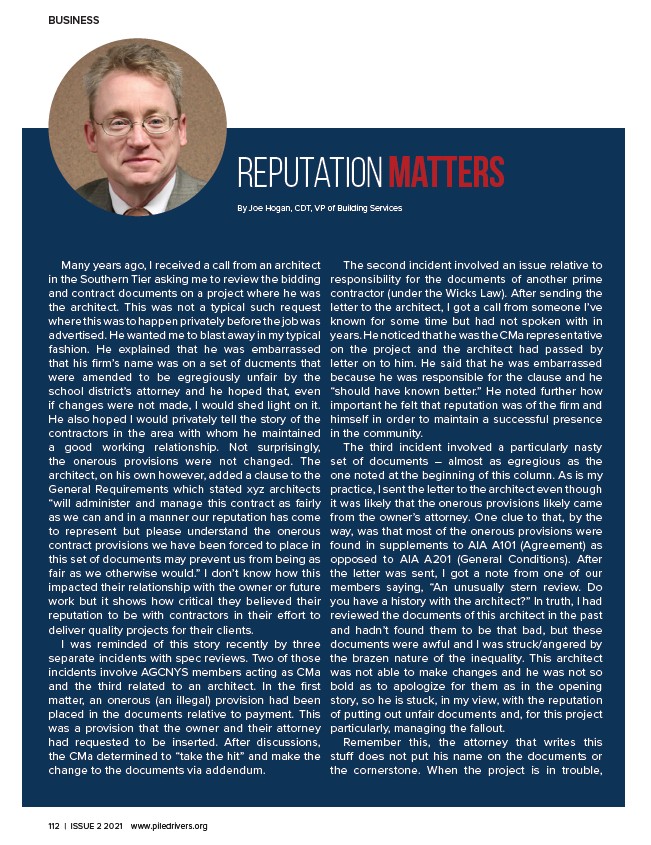
BUSINESS
Reputation matters
By Joe Hogan, CDT, VP of Building Services
Many years ago, I received a call from an architect
in the Southern Tier asking me to review the bidding
and contract documents on a project where he was
the architect. This was not a typical such request
where this was to happen privately before the job was
advertised. He wanted me to blast away in my typical
fashion. He explained that he was embarrassed
that his firm’s name was on a set of ducments that
were amended to be egregiously unfair by the
school district’s attorney and he hoped that, even
if changes were not made, I would shed light on it.
He also hoped I would privately tell the story of the
contractors in the area with whom he maintained
a good working relationship. Not surprisingly,
the onerous provisions were not changed. The
architect, on his own however, added a clause to the
General Requirements which stated xyz architects
“will administer and manage this contract as fairly
as we can and in a manner our reputation has come
to represent but please understand the onerous
contract provisions we have been forced to place in
this set of documents may prevent us from being as
fair as we otherwise would.” I don’t know how this
impacted their relationship with the owner or future
work but it shows how critical they believed their
reputation to be with contractors in their effort to
deliver quality projects for their clients.
I was reminded of this story recently by three
separate incidents with spec reviews. Two of those
incidents involve AGCNYS members acting as CMa
and the third related to an architect. In the first
matter, an onerous (an illegal) provision had been
placed in the documents relative to payment. This
was a provision that the owner and their attorney
had requested to be inserted. After discussions,
the CMa determined to “take the hit” and make the
change to the documents via addendum.
The second incident involved an issue relative to
responsibility for the documents of another prime
contractor (under the Wicks Law). After sending the
letter to the architect, I got a call from someone I’ve
known for some time but had not spoken with in
years. He noticed that he was the CMa representative
on the project and the architect had passed by
letter on to him. He said that he was embarrassed
because he was responsible for the clause and he
“should have known better.” He noted further how
important he felt that reputation was of the firm and
himself in order to maintain a successful presence
in the community.
The third incident involved a particularly nasty
set of documents – almost as egregious as the
one noted at the beginning of this column. As is my
practice, I sent the letter to the architect even though
it was likely that the onerous provisions likely came
from the owner’s attorney. One clue to that, by the
way, was that most of the onerous provisions were
found in supplements to AIA A101 (Agreement) as
opposed to AIA A201 (General Conditions). After
the letter was sent, I got a note from one of our
members saying, “An unusually stern review. Do
you have a history with the architect?” In truth, I had
reviewed the documents of this architect in the past
and hadn’t found them to be that bad, but these
documents were awful and I was struck/angered by
the brazen nature of the inequality. This architect
was not able to make changes and he was not so
bold as to apologize for them as in the opening
story, so he is stuck, in my view, with the reputation
of putting out unfair documents and, for this project
particularly, managing the fallout.
Remember this, the attorney that writes this
stuff does not put his name on the documents or
the cornerstone. When the project is in trouble,
112 | ISSUE 2 2021 www.piledrivers.org